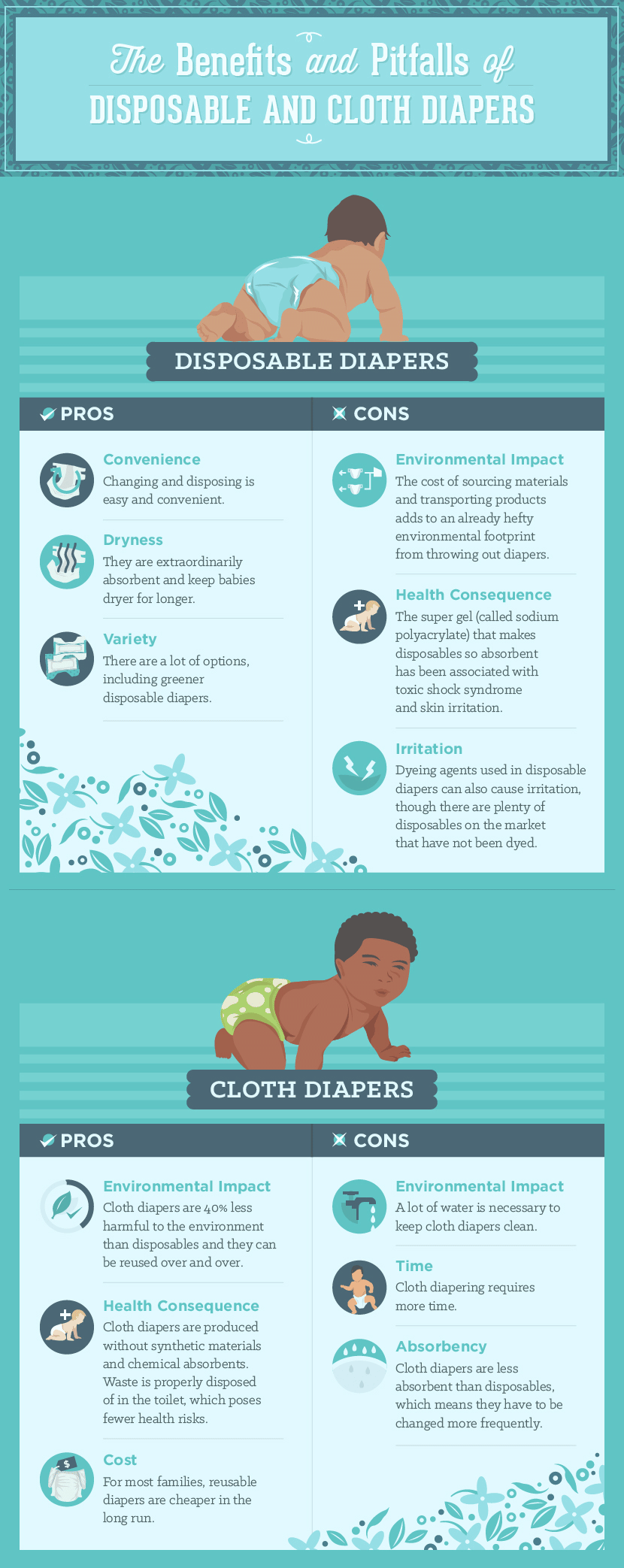Adding an extra member to your family? Trying to decide whether to use disposable diapers or try your hand at cloth diapers? Are cloth diapers really a more environmentally friendly option? What about all the water used in washing? What about the pesticides used to make cotton?
Before we start comparing the two options, let’s think about how many diapers the average baby will need.
- Most babies are in diapers for 2-3 years.
- During infancy the average baby goes through 12 diapers a day.
- As they get older they will use less diapers each day, with a toddler using 4-6 diapers on average.
- If we use 8 diapers for our calculations, that’s 2,920 diapers each year and 7,300 total diapers over 2.5 years.
Disposable Diapers
The primary environmental impact of disposable diapers is the waste. Most parents take the dirty diaper off, lock it inside a Diaper Genie, and send it out with the weekly garbage. Then the diapers are buried inside a landfill where they will sit for approximately 500 years. There aren’t any widely available recycling options for a disposable diaper, although there are some other countries that have researched this option. Diapers aren’t the only waste created from changing diapers though, there are also disposable wipes, packaging waste, and garbage bags.
In addition to waste, there are other environmental impacts of a disposable diaper.
- A disposable diaper is made of wood pulp and synthetic materials. The absorbent core is commonly made from wood pulp and sodium polyacrylate, with an inner layer of polypropylene (and possibly fragrances).
- The manufacturing of wood pulp alone uses a lot of water and creates additional waste that needs to be treated on-site. Some of the more eco-friendly disposable diapers are made from plant material (like wheat or corn).
- Most (but not all) disposable diapers have been bleached in the process to make them white.
- A lot of the popular disposable diaper brands are made here in the US or in nearby Mexico, but some brands state that they are made of domestic and imported materials. You have to factor in the transportation and petroleum impacts for transporting the raw materials and the finished product.
As you can see, there are a lot of other factors involved in the manufacturing and distribution of a disposable diaper that creates an immeasurable environmental impact. Not all disposable diapers will have the same environmental impact.

Cloth Diapers
Just like disposable diapers, cloth diapers come in many different styles and fabrics. Modern cloth diapers are typically made up of a waterproof PUL (plastic material) diaper cover (or shell) and an inner absorbent material. The absorbent inserts can be made of synthetic microfiber or natural fibers (cotton, hemp, or bamboo blends). Most modern diapers also have plastic snaps or Velcro closures. There are also plastic-free options like prefolds and wool covers which are more environmentally friendly.
Cloth diapers can be used again and again, most can be used for multiple children. The elastic and Velcro may need to be replaced after a few years, but when cared for properly, will last for a long time. When you are done with diapers you can resell them or donate them to a cloth diaper bank that supports families who cannot afford diapers.
In the US, there are a lot of domestically sourced and manufactured cloth diaper brands. Since most of the cloth diaper manufacturers are small businesses, they try to locally source as much as possible. There is minimal packaging required for cloth diapers and most companies use paper or cardboard packaging, made from recycled content. Companies, like Thirsites, use 90% of their fabric for their products and recycle diaper scraps into insulation and other products.
For the most environmentally friendly diapers, you’ll want to look for organic cotton and other unbleached natural fibers (like bamboo and hemp). Other common fabric options in diapers include synthetic microfleece, microsuede, and microfiber. There are some environmental impacts from the manufacturing of these fabrics, but remember you only need to buy cloth diapers one time.
In the manufacturing and distribution, there aren’t many other environmental impacts. The biggest concern environmentally with cloth diapers is water usage. Many families, especially those in areas that have water restrictions, are concerned about the extra water and electricity usage in laundering their diapers. Cloth diapers typically need to be washed 1-3 times a week depending on how many you have. Most high-efficiency washers use 15-30 gallons of water per load, and older machines use around 30-50 gallons of water per load. You can even wash your diapers with regular clothes if you’re trying to conserve water (do a short pre-rinse on the diapers first to remove most of the pee, poop is flushed in the toilet). There is also some water usage in the manufacturing of the fabric.
The biggest difference between disposable diapers and cloth diapers is the total number of diapers that you need to diaper your baby. To wash twice a week, you’ll need about 24-36 cloth diapers. A disposable diaper family would use about 7,300 diapers for 2.5 years. 7,300 cloth diapers could diaper 243 families for 2.5 years and another 243 families for another 2.5 years, the cycle continues until the diapers are no longer usable.
When cloth diapers are no longer usable you can use them for cleaning up around the house or crafted into a keepsake stuffed animal.
In addition to the environmental impacts of disposables and cloth diapers, there are financial and health impacts of both. The choice is yours and doesn’t have to be all-or-nothing, using cloth diapers part-time can still reduce your environmental impact.

Feature image courtesy of Philippe Put

